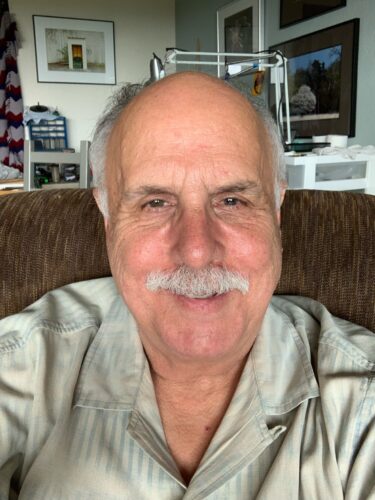 Mark Johnson is currently involved with the University of Washington Retirement Association. Mark graduated from Edmonds High School and retired in 2013 after working as a maintenance painter at the UWMC for 30 years.
Mark Johnson is currently involved with the University of Washington Retirement Association. Mark graduated from Edmonds High School and retired in 2013 after working as a maintenance painter at the UWMC for 30 years.
This interview is a part of a series on ageism, completed by de Tornyay Center predoctoral scholar, Sarah McKiddy (sm256@uw.edu). Read her article on ageism here, and find more interviews on ageism here.
Intergenerational activities are one way we can increase age diversity throughout the community. What do you think would be meaningful intergenerational activities?
In the retirement association, there was an organization called Encore.org about giving back and taking your expertise and getting involved with younger people with activities like tutoring and mentoring.
Classic involvement would involve grandparents acting in caregiver roles and passing on knowledge. The logistics of getting people together can be tough but finding things of common interest and including everybody would garner compassion, and we need to give and receive more compassion in this world.
One of the programs in the retirement association is called ‘Member to Member.’ We recently gathered a few people who are retired authors who just published a book. We also have a mediator and then they discuss the processes of writing and publication. We also had artists discuss their work and the art community. Everything is recorded on Zoom. In the past, it was live, but we have adjusted to hybrid events and are able to reach wider audiences now.
Ageism is considered one of the unchallenged isms and is defined as discrimination based on age. How would you define it? Where do you see it?
I’m involved in aging in another aspect in that my mother just turned 99 last week and she’s in assisted living now but I am pretty much the primary care person for her. That gives me quite a perspective of what my future could look like. What my mother needs most from me is my presence and reassuring touch.
Part of the issues surrounding ageism is cultural. On a societal level, we need to look at how the family and the community deal with and take care of older adults. I know in other cultures that older adults remain close to the family and at home, but that’s even rapidly changing in modern times. There’s a detachment there. There’s not this obvious obligation or commitment to older adults. I’m really my mom’s advocate, and I see all the other residents there, and I am by far the huge exception to the rest of the people. Staff and movers were blown away that our family was there to help move my mom in. So, it’s kind of the way our society has gotten, and it has become an out-of-mind, out-of-sight phenomenon.
Sometimes you feel like with increasing age, you are slipping off the radar. It used to be retirement at 65 and then the “golden years.” Dealing with stigmas is a major obstacle. We don’t want to talk about older age, and we don’t want to “see” the institutionalized systems for older adults. When I retired at 62, my mother was 92, so I thought about how I had a whole new career and life ahead of me. There’s a lot of aspects that I need to accomplish to make the most out of that, and it’s not how long I can live; it’s how well I can live.